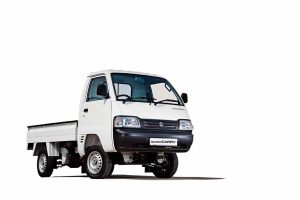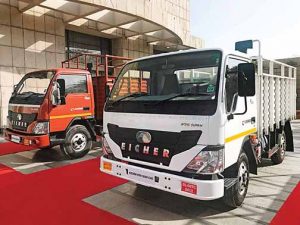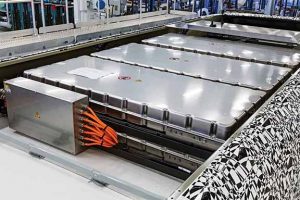Bhushan Mhapralkar
Yadav drives a CNG version of the Tata Ace for the pharmaceutical chain Noble in Mumbai. A closed body construction, the vehicle travels across the city to supply medicines to the pharmacy chain for the better part of the day. Almost every alternate day, it travels to Pune to deliver medicines to the Noble chain there. Better and more drive-able than the diesel variant, according to Yadav, the CNG Ace is proving to be reliable and productive. It is supported ably by the CNG infrastructure in Mumbai and Pune. A part of Noble’s strategy to deploy CNG vehicles over diesel, according to Yadav, in the interest of efficiency and cost, the CNG Ace has run a good 78,000 kms already. It was bought a little less than a year ago. An example of a shift taking place in urban regions where CNG is available, the factors that are attracting operators towards it are new technologies like turbocharging, light-weighting, low friction components, and higher capacity engines. These are empowering CNG CVs to perform better, prove to be efficient and reliable. The most interesting part of the equation perhaps is that they are turning out to be as drive-able if not more than their diesel variants. Averred Yadav, that he finds the CNG Ace to be more driveable than the diesel variant. In a BSVI scenario, the new generation of CNG CVs is paving the way for a greener future, especially when the cost and efforts to upgrade diesel CVs is amounting to a significant portion. In fact, the advent of BSVI is said to push many CV manufacturers to kill their diesel CVs in the SCV and LCV segments. In their place, CNG CVs and petrol ones are being promoted.
Mentioned a Maruti Suzuki dealer in Delhi NCR that he has been witnessing good traction for the CNG Super Carry. He attributed this to the operating cost advantage the vehicle offers over its diesel variant. Drawing attention to the strategy of its principal to make its entire small car portfolio available in CNG, the dealer stated that come April 01, 2020, and the Super Carry will be available only in CNG and petrol versions. Witnessing its market share in FY2018-19 grow by four-per cent with the sale of 23,874 Super Carry units as compared to the sale of 10,033 units in the last fiscal, Maruti Suzuki has been vocal about the costs and other challenges involved in the upgrading of small diesel engines. It has been vocal about how it does not make a sound business case either. With most SCVs falling in the M1 category, there’s also the safety angle that has got some manufacturers to withdraw some models that were propelled by a single or two-cylinder diesel engine and enjoyed a good pull. Regulations, it is clear, is driving a change not only in terms of emissions but also in terms of safety and costs. With many passenger commercial vehicles taking to CNG, it has come to be an alternative to diesel in many urban and semi-urban regions. Securing BSVI certification for its 3.8-litre naturally aspirated sequential injection CNG engine for CV application, market leader Tata Motors has been quite active with its CNG range. Securing BSVI certification for its E483, four-cylinder, 3.3-litre CNG engine, VE Commercial Vehicles Ltd. has been pushing its range of CNG CVs in markets like Delhi NCR and Mumbai as a cost-competitive and reliable alternative to diesel.
Advantage gas
Terming the E483 CNG engine as a robust and competitive alternative to the end customers, Vinod Aggarwal, MD and CEO, VE Commercial Vehicles Ltd., mentioned that they used the expertise they have gained from producing EuroVI compliant engines for Volvo Group to come out with the BSVI compliant CNG engine. Another CV manufacturer that has been cornering a good share of the CNG CV market is SML Isuzu. The CV maker launched the turbocharged Sartaj GS CNG at Auto Expo 2018. The lorry has a GVW of 7.2-tonnes. Its 3.5-litre engine produces 100 hp. Speaking at the launch, SML Isuzu CEO and MD Eiichi Seto said, that they are striving to keep themselves updated with the latest trends in the industry in the wake of BSVI emission norms as well as the encouragement for eco-friendly vehicles. With growing concerns about the use of fossil fuels in view of the burgeoning oil import bill, rising levels of air pollution, CO2 emissions and depleting stocks of mineral oils like gasoline and diesel, CNG, according to an industry source, is set to prove to be a low hanging fruit until the environment is ripe for some higher blends of bio-fuels and electricity.
With questions regarding the generation of electricity by burning lignite or diesel being raised, CNG is looking like a good alternative to reducing air pollution. Drawing attention to the speech of Dharmendra Pradhan, the minister of petroleum and natural gas at the 2018 annual convention of the Society of Indian Automotive Manufacturers (SIAM), that 10,000 CNG gas stations will be rolled out in a decade, the source stated that such solutions need to be promoted widely until truly sustainable green energy mediums are found. One of them could be hydrogen, he added. Announcing that they are eyeing the three-wheeler CNG segment with an innovative EFI system, Akshay Kashyap, Founder and Managing Director, Greenfuel Energy Solutions, averred that the use of gas-propelled CVs will rise to 15 per cent by 2021. He opined that it is at a nascent stage at the moment. Supplying CNG systems to Maruti Suzuki, Tata Motors, Ashok Leyland, Volvo Eicher, and SML Isuzu, Greenfuel Energy Solutions claims to do a good deal of development work in-house in anticipation of a considerable spike in demand for CNG vehicles once BSVI emission norms come into force. The company is leveraging its experience to develop CNG system components and technology to address the requirements of Indian customers.
LNG and electric
The transition to BSVI expected to push the demand for CNG, business arrangements like the partnership of Tata Motors with Canada’s Westport Fuel Systems to develop and supply four- and six-cylinder natural gas spark-ignited engine parts for commercial vehicles are certain to grab attention. Stated the industry source, that in the BSVI environment, the role of greener fuel mediums like CNG will assume a bigger role. Especially at a level where new regulations, including the CAFE norms, affect cost and technology will it matter the most, he remarked. Of the firm belief that regulations like CAFE norms will lead to many changes, the source explained that CV makers have been fine-tuning their strategy to identify and pursue technologies that will be sustainable in the near and mid-term, and in the long-term. For long-haul CVs, LNG could prove to be a good alternative to electricity. It was roughly two years ago that Tata Motors displayed an LNG-powered bus in India. It followed up with the display of an LNG HGV. Drawing attention to the news of US-based Tellurian Inc., signing an agreement to sell gas to Petronet LNG in the presence of prime minister Narendra Modi at a price of USD-six per unit, another source stated, that it would amount to a much lower price than the ceiling for output from the difficult fields in India. With LNG set to prove price competitive in the wake of this development, it would be worth developing an infrastructure for it.
Stating that there is only one LNG cryogenic tank producer in India, a CV industry source informed, that the range limitation and weight disadvantage faced by electric long-haul HGVs could be resolved with the use of this fuel. Petronet LNG, he added, is in advanced talks with oil marketing companies to set up LNG stations at petrol pumps on highways. While advancements in the area of hydrogen cell could turn electrification as the ultimate green propulsion, questions being raised regarding the CO2 emissions of Lithium-ion batteries that could make a comparable diesel vehicle more eco-friendly, the availability of CNG and LNG as alternate fuels makes a good premise to quickly reduce vehicular pollution levels in the country. Looking at ways to generate electricity through green sources, BSVI norms coming in force from April 2020, are set to unleash a new set of challenges. Drawing attention to how dependence on natural gas, which is cleaner than coal, has increased in California, and how the Greenhouse gas emissions have fallen by 13 per cent since 2004 because the cost of renewable energy has decreased, a source averred that challenges like Li-ion batteries not able to store energy for long enough could limit the scope of electrification.
Emission reduction through automation
The need to scale up as per the need is a challenge in case of most alternative fuels. China, which has had the world’s largest carbon footprint since 2004, and was responsible for 28.3 per cent of global carbon dioxide emissions in 2017, is upgrading its power grid with more efficient ‘ultra-supercritical’ plants. These produce more energy with less coal. Also, the third-largest purchaser of LNG from the US, China, at the forefront of creating good infrastructure for electric vehicles, has been pushing automation in vehicles to improve air quality. In India, automation may look far fetched when one looks at the road infrastructure, quality of roads, and driving habits. It could be achieved however in smaller ways to be advantageous in improving efficiency and reducing emissions. A study in the US found out that three factors mattered the most. These were the effect on the total vehicle-miles traveled, impact on congestion and fuel efficiency. A study by the Massachusetts Institute of Technology’s Senseable City Laboratory concluded that considerable emission reduction could be achieved through automation in urban areas for a vehicle involved in ride-sharing programs (in the case of people movement). It would be born out of the need to not look for a suitable parking space! Interestingly, ride-sharing platforms like Shuttl come to mind. Similar arrangement for goods vehicles in urban regions with the help of pick-up centres is already in the making, and would eventually result in the fine-tuning of the hub and spoke transportation model. It would also help to reduce emissions.
The working paper for 2018 by the International Council on Clean Transportation by Peter Slowik and Ben Sharpe mentioned that the implications of autonomous trucking are broad and extend beyond the trucking sector to include infrastructure, urban planning, cyber-security, privacy and insurance. The authors made an observation that from a typical fleet perspective, the potential impacts of autonomous trucking include improvement in safety, ease of driving, higher operational efficiency, reduced labour costs, greater fuel efficiency, and lower emissions. Some of the simple technologies that would lead to advanced levels of automation, and in the process reduce emissions as well as fuel efficiency, include lane departure warning, blind-spot detection, automatic braking, AMT, eco-driving systems, automated lane-keeping, adaptive cruise control, predictive cruise control, platooning and telematics. If an emphasis on precise fuel tracking is necessary to analyse fuel consumption and driving habits concerning emissions, measures like platooning could be sought by tackling issues like the number of freight miles to be run. In platooning trials that have been conducted in limited real-world conditions, it has been observed that fuel consumption reduces since the air resistance of trucks that follow the lead truck is considerably less. The achievement of Level 2 automation, which would ideally comprise of some of the technologies mentioned above, the fuel savings would be in the area of four to 15 per cent. This would also have a significant impact on emissions and costs.



























